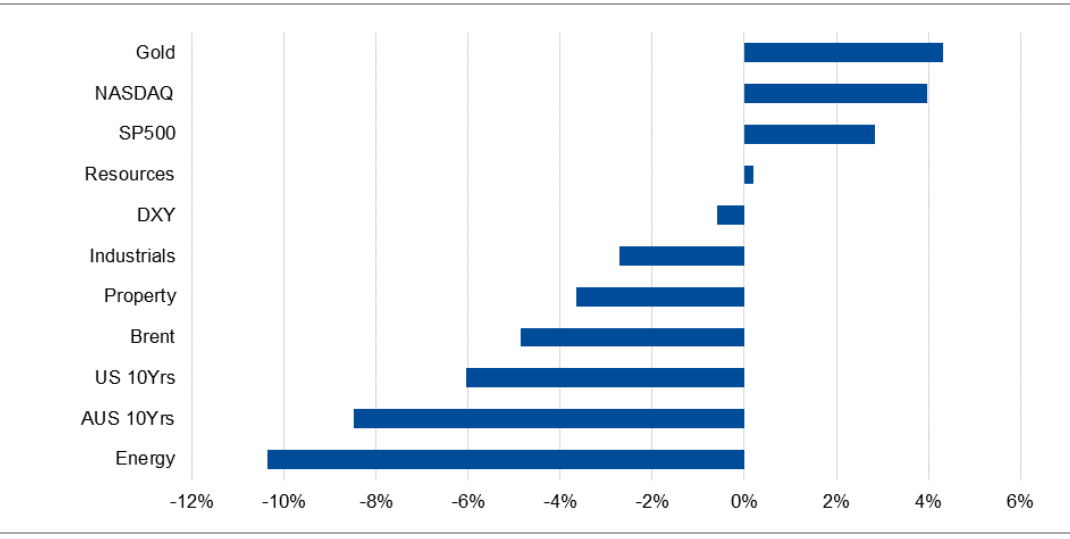Investment Watch: Summer 2026 Outlook
Investment Watch is a quarterly publication delivering insights into equity strategy and economic trends. The Summer 2026 edition explores global and Australian growth outlooks, structural shifts in asset allocation, and highlights opportunities across AI, resources, property, and income strategies to help investors navigate volatility and prosper in the year ahead.
Investment Watch is a quarterly publication produced by Morgans that delves into key insights for equity and economic strategy.
This publication covers
Economics - 'The Australian economy: a landscape of challenge and opportunity'
Asset Allocation - 'Structural shifts demand a portfolio rethink'
Equity Strategy - 'Diversification is key'
Banks - 'Fundamentals don't justify share price strength'
Industrials - 'Prepared for the uptick'
Travel - 'Selective opportunities'
Resources and Energy - 'Steady China and tight supply'
Consumer discretionary - 'Recovery underway'
Healthcare - 'Attractive, but with limited opportunities'
Infrastructure - 'Rising cost of capital but resilient operations'
Property - 'Structural tailwinds building'
It’s hard to believe that 2025 is already drawing to a close. As we enter the holiday season, we want to take a moment to express our deepest gratitude for your continued support and trust. This trust is the very foundation of everything we do. This time of year is a chance to reflect on the significant progress we’ve made. The entire team at Morgans is incredibly proud of the efforts and achievements from the past twelve months that reinforce our commitment to providing you with top-tier advice and opportunities. These achievements mean that Morgans continues to provide top-line advice and investment opportunities that benefit clients across our national branch network.
Morgans clients receive exclusive insights such as access to our latest Investment Watch publication. Contact us today to begin your journey with Morgans.
In this analysis, we delve into recent developments in the telecommunications (telco) sector, focusing on NBN and mobile pricing trends, updates on significant events such as the 5G spectrum auction, and our adjusted forecasts. Additionally, we'll discuss our revised sector view and provide insights into specific companies within the industry.
Revised Sector View
Based on our comprehensive analysis, we have adjusted our sector view for the telecommunications industry. This assessment considers various factors, including market dynamics, regulatory changes, and company performance.
Telstra Group (ASX:TLS)
While Telstra Group (ASX:TLS) remains a key player in the telco sector, we maintain a Hold rating on the stock. This decision is influenced by the perceived risk/reward profile, which we believe is negatively weighted due to its premium valuation.
TPG Telecom (ASX:TPG)
Conversely, we have an Add rating on TPG Telecom (ASX:TPG). We see a more favorable risk/reward scenario for TPG Telecom, driven by its comparatively lower valuation within the sector.
Superloop (ASX:SLC)
Despite its status in the small-cap segment, Superloop (ASX:SLC) continues to exhibit promising potential. We maintain an Add rating on Superloop, considering it to offer the best value proposition within its category.
In conclusion, the telco sector is undergoing significant changes, influenced by pricing trends, regulatory developments, and technological advancements.
<<Insert button>>
In this analysis, we delve into the prospects of Aurizon Holdings (ASX:AZJ) and its anticipated performance in the upcoming fiscal years. While the company shows promising signs of robust EBITDA growth in FY24 and onwards, there are certain factors that might hinder its potential. Here, we examine the growth trajectory, dividend projections, and overall investment outlook for Aurizon Holdings.
Growth Projections
We anticipate Aurizon Holdings to exhibit significant EBITDA growth throughout FY24, with continued albeit slightly subdued growth in FY25-26. However, it's crucial to note that the potential escalation in debt service obligations might not be fully acknowledged in current market assessments.
Financial Outlook
Our analysis suggests a mid-teen compound growth in both earnings per share (EPS) and dividends per share (DPS) across FY24-26F. Notably, our forecast for FY26F dividends implies a noteworthy 7.1% cash yield at present prices, compared to 4.7% for FY24F. This signifies an attractive dividend proposition for investors considering Aurizon Holdings.
Investment Insights
Given the current market dynamics and our price target (accessible with login), we maintain a recommendation to HOLD Aurizon Holdings at current price levels. This stance is supported by the approximate 6% potential Total Shareholder Return (TSR) anticipated.
In conclusion, while Aurizon Holdings presents a solid growth narrative, it's essential for investors to consider the underlying factors, such as debt service obligations, before making investment decisions. With careful analysis and monitoring, Aurizon Holdings could still present an attractive investment opportunity despite the current pricing dynamics.
- Morgans research analysts re-set their sector views, strategies and best ideas as dynamic forces continue to challenge markets.
- Our approach in equities currently favours stocks with compelling risk/reward profiles among quality cyclicals and select mid-to-small caps.
- Preferred equity sectors include staples, healthcare and financials along with select travel exposure.
Our base case remains a cyclical slowdown / mild recession
Our Asset Allocation Update – 2024 Outlook discusses three possible economic scenarios in 2024 and their investment implications in terms of portfolio asset allocation. Our base case scenario expects economic growth to contract in the first half of 2024 before returning to growth later in the year. Sticky inflation will keep interest rates higher for longer. Equities will likely remain rangebound until there is more certainty on the interest rate trajectory either peaking/falling.
This scenario could have an interesting dynamic around small and mid-cap stocks. These companies were derated in 2023 as they grappled with higher interest rates, and their risk-reward profile looks attractive despite the recession risks. With central banks on high alert for persistent inflation, short-dated, high-quality credit should form the core part of the fixed income allocation. A mild recession would be positive for property because a small amount of inflation is positive for real estate. Furthermore, REIT prices have declined materially, which could lead to opportunities in areas that investors have overlooked in 2023 (retail/commercial REITs).
Given Australia’s economic sensitivity to falling commodity prices, investors need to tread carefully over the next 3-6 months. As tailwinds from commodity prices fade, we think above-average earnings growth for the market will be harder to come by. Accordingly, we prefer a targeted portfolio approach, tilting toward what we believe are the best relative opportunities and the best risk/return profile e.g., small caps, quality cyclicals.
Morgans sector analysts have downgraded their rating on the Telco sector to Slightly Underweight (from Neutral). Telco sits in the expensive defensive basket with the positives looking priced in. The sector could easily see downside risks, potentially as a funding source for a rotation into growth sectors in 2024.
Relative 3-month asset class performances

Morgans clients receive access to detailed market analysis and insights, provided by our award-winning research team. Begin your journey with Morgans today to view the exclusive coverage.
Our best ideas are those that we think offer the highest risk-adjusted returns over a 12-month timeframe supported by a higher-than-average level of confidence. They are our most preferred sector exposures.
Additions: This month we add Super Retail Group (ASX:SUL)
Removals: This month we remove Commonwealth Bank (ASX:CBA) and Accent Group (ASX:AX1).
Large cap best ideas
Westpac Banking Corp (ASX:WBC)
WBC has a similar asset base, funding mix and domestic retail concentration as the premium priced CBA. However, its growth, profitability and ROE have been significantly weaker than this larger competitor, which is ultimately reflected in WBC’s lower earnings and asset-based trading multiples and higher cash yield. If WBC can materially improve its business performance (this is not without significant risk of disappointment) then an investment in its stock could deliver attractive returns as the share price rerates upwards and cash returns to investors lift.
Wesfarmers (ASX:WES)
WES possesses one of the highest quality retail portfolios in Australia with strong brands including Bunnings, Kmart and Officeworks. The company is run by a highly regarded management team and the balance sheet is healthy. We believe WES’s businesses, which have a strong focus on value, remain well-placed for growth and market share gains in a softening macroeconomic environment.
Treasury Wine Estates (ASX:TWE)
It may take some time for the market to digest TWE’s acquisition of Paso Robles luxury wine business, DAOU Vineyards (DAOU) for US$900m (A$1.4bn) given it required a large capital raising. The acquisition is in line with TWE’s premiumisation and growth strategy and will strengthen a key gap in Treasury Americas (TA) portfolio. Importantly, DAOU has generated solid earnings growth and is a high margin business. It consequently allowed TWE to upgrade its margins targets. While not without risk given the size of this transaction, if TWE delivers on its investment case, there is material upside to our valuation. The key near term share price catalyst is if China removes the tariffs on Australian wine imports.
Santos (ASX:STO)
The resilience of STO's growth profile and diversified earnings base see it well placed to outperform against the backdrop of a broader sector recovery. While pre-FEED, we see Dorado as likely to provide attractive growth for STO, while its recent acquisition increasing its stake in Darwin LNG has increased our confidence in Barossa's development. PNG growth meanwhile remains a riskier proposition, with the government adamant it will keep a larger share of economic rents while operator Exxon has significantly deferred growth plans across its global portfolio.
Macquarie Group (ASX:MQG)
We continue to like MQG’s exposure to long-term structural growth areas such as infrastructure and renewables. The company also stands to benefit from recent market volatility through its trading businesses, while it continues to gain market share in Australian mortgages.
CSL Limited (ASX:CSL)
While shares have struggled of late, we continue to view CSL as a key portfolio holding and sector pick, offering double-digit recovery in earnings growth as plasma collections increase, new products get approved and influenza vaccine uptake increases around ongoing concerns about respiratory viruses, with shares trading at 25x, a substantial discount (20%) to its long-term average.
ResMed Inc (ASX:RMD)
While weight loss drugs have grabbed headlines and investor attention, we see these products having little impact on the large, underserved sleep disorder breathing market, and do not view them as category killers. Although quarters are likely to remain volatile, nothing changes our view that the company remains well placed and uniquely positioned as it builds a patient-centric, connected-care digital platform that addresses the main pinch points across the healthcare value chain.
Transurban (ASX:TCL)
TCL owns a pure play portfolio of toll road concession assets located in Melbourne, Sydney, Brisbane, and North America. This provides exposure to regional population and employment growth and urbanisation. Given very high EBITDA margins, earnings are driven by traffic growth (with recovery from COVID) and toll escalation (roughly 70% by at least CPI and approximately one-quarter at a fixed c.4.25% pa). We think TCL will continue to be attractive to investors given its market cap weighting (important for passive index tracking flows), the high quality of its assets, management team, balance sheet, and growth prospects.
QBE Insurance Group (ASX:QBE)
With strong rate increases still flowing through QBE's insurance book, and further cost-out benefits to come, we expect QBE's earnings profile to improve strongly over the next few years. The stock also has a robust balance sheet and remains relatively inexpensive overall trading on 8x FY24F PE.
Aristocrat Leisure (ASX:ALL)
We have three key reasons for being positive on ALL. They are: (1) long-term organic growth potential. ALL is better capitalised than many of its competitors and has what we regard as a strong platform to continue investment in design and development in both its land-based gaming and digital businesses; (2) strong cash conversion and ROCE. ALL is a capital-light business despite its ongoing investment in Gaming Operations capex and working capital. It has a high level of cash conversion and ROCE; and (3) strong platform for investment. ALL has funding capacity for organic and inorganic investment in online RMG, even after the recent buyback. Its current available liquidity is $3.8bn.
Mineral Resources (ASX:MIN)
MIN is a founder-led business and top tier miner and crusher that has grown consistently despite barely issuing a share over the last decade. Also helping our investment view is that MIN’s diversification leaves it far more capable of tolerating volatility in lithium markets than its peers in the sector. We see MIN’s lithium / iron ore market exposures as an ideal combination to benefit from the China gradual recover. We also see MIN as well placed to grow into its valuation, even if we see unexpected metal price volatility, given the magnitude of organic growth in the pipeline.
South32 (ASX:S32)
S32 has transformed its portfolio by divesting South African thermal coal and acquiring an interest in Chile copper, substantially boosting group earnings quality, as well as S32's risk and ESG profile. Unlike its peers amongst ASX-listed large-cap miners, S32 is not exposed to iron ore. Instead offering a highly diversified portfolio of base metals and metallurgical coal (with most of these metals enjoying solid price strength). We see attractive long-term value potential in S32 from de-risking of its growth portfolio, the potential for further portfolio changes, and an earnings-linked dividend policy.
Goodman Group (ASX:GMG)
GMG represents c.27% of the ASX A-REIT index and is one of the few offshore earners in the A-REIT space. GMG rarely screens cheap against domestic peers, but within the context of its offshore peers, it consistently delivers higher returns at lower levels of leverage and at a comparable price to book ratio. Growth in Assets Under Management and development completions are a key determinant of value and an AUM of A$80bn (US$50m) is comparatively modest in a global context, whilst A$7bn (US$5.5n) of completions pa we see as likely sustainable. With continued increases in interest rates and persistent inflation (most notably construction costs), risks abound the REIT sector. This drives our preference for beds and sheds, reflecting the strength of those underlying operating markets. Given the duration risk from higher rates, we prefer more active managers who can grow AUM and add value from an active buy, build, manage strategy. To this end, strong balance sheets are also key to navigate any deterioration in book values.
Qantas Airways (ASX:QAN)
QAN is trading at a material discount compared to pre-COVID multiples, despite having structurally higher earnings, a much stronger balance sheet, a better domestic market position, a higher returning International business and more diversification (stronger Loyalty/Freight earnings). The strong pent-up demand to travel post-COVID should result in a healthy demand environment for some time, underpinning further earnings growth over FY24/25. QAN’s balance sheet strength positions it extremely well for its upcoming EBIT-accretive fleet reinvestment and further capital management initiatives (recently announced another A$500m on-market share buyback at its FY23 result).
Morgans clients can download our full list of Best Ideas, including our mid-cap and small-cap key stock picks.
Your Wealth is a half-yearly publication produced by Morgans, that delves into key insights for Wealth Management, including the key spotlight article ‘Innovative retirement income streams.’
This latest publication will also cover giving an early inheritance to your children, an economic update addressing a slowdown in US economic growth, and SMSF trustee education, emphasising the significance of a written investment strategy.
Download your copy today to receive the latest insights.
Innovative Retirement Income Streams
In February 2022, legislation was enacted which inserted a new covenant into the Superannuation Act that requires trustees of superannuation entities to develop a retirement income strategy for Australians who are retired or are approaching retirement. This covenant is known as the Retirement Income Covenant and requires large (non-SMSF) super fund trustees to have a strategy to assist beneficiaries to achieve and balance the following three objectives:
- maximising expected retirement income;
- managing expected risks to the sustainability and stability of their expected retirement income; and
- having flexible access to expected funds during retirement.
Since then, a number of new innovative products have been developed and introduced to the market.
Morgans has reviewed a number of these innovative products, the details of which are summarised in the latest publication of Your Wealth.
Morgans Chief Economist Michael Knox says that core Australian CPI numbers still suggests another RBA rate hike. However, we may not see rates rise until February 2024.













